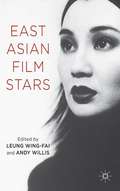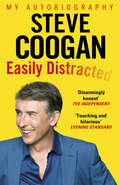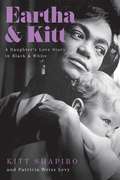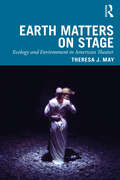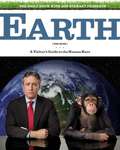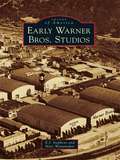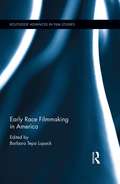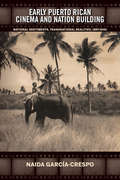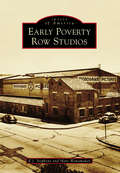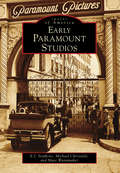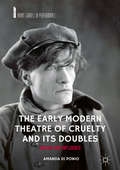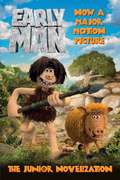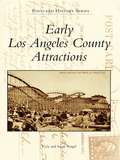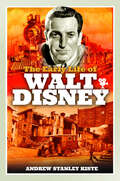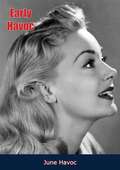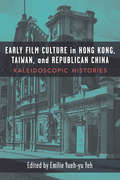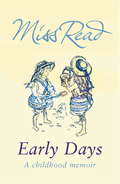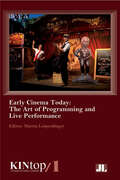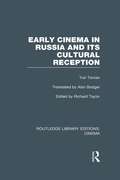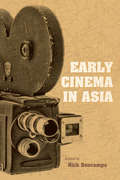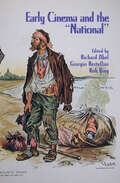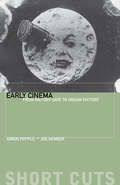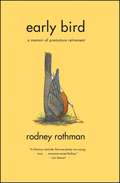- Table View
- List View
East Asian Film Stars
by Leung Wing-Fai Andy WillisMany stars from China, Japan and Korea are the most popular and instantly recognizable in the world. East Asian Film Stars brings together some of the world's leading cinema scholars to offer their insights into the work of regional and transnational screen legends, contemporary superstars and mysterious cult personas.
Easily Distracted
by Steve CooganSteve Coogan was born and raised in Manchester in the 1960s, the fourth of six children. From an early age he entertained his family with impressions and was often told he should 'be on the telly'. Failing to get into any of the London-based drama schools, he accepted a place at Manchester Polytechnic School of Theatre and before graduating had been given his first break as a voice artist on the satirical puppet show Spitting Image. The late eighties and early nineties saw Coogan developing characters he could perform on the comedy circuit, from Ernest Moss to Paul Calf, and in 1992 he won a Perrier award with John Thomson. It was around the same time, while working with Armando Iannucci and Patrick Marber on On The Hour and The Day Today, that Alan Partridge emerged, almost fully formed. Coogan, once a tabloid fixture, is now a respected film actor, writer and producer. He runs his own production company, Baby Cow, has a raft of films to his name (from 24 Hour Party People to Alpha Papa, the critically-acclaimed Partridge film), six Baftas and seven Comedy Awards. He has found huge success in recent years with both The Trip and Philomena, the latter bringing him two Oscar nominations, for producing and co-writing.In Easily Distracted he lifts the lid on the real Steve Coogan, writing with distinctive humour and an unexpected candour about a noisy childhood surrounded by foster kids, his attention-seeking teenage years and his emergence as a household name with the birth of Alan Partridge.
Eartha & Kitt: A Daughter's Love Story in Black and White
by Kitt ShapiroA luminous and inspiring portrait of a Black pioneer and artistic force—Eartha Kitt—and one of the most moving mother/daughter stories in Hollywood history.In this unique combination of African-American, music, and cultural history, we come to know one of the greatest stars the world has ever seen—Eartha Kitt—as revealed by the person who knew her best, her daughter. Eartha, who was a mix of Black, Cherokee, and white, identified as Black, but Kitt, her biological daughter by a white man, is blonde and pale. This is the story of a little white girl raised by her natural mother, who was the biggest Black celebrity in the world. For three decades until Kitt finally married, they traveled the world together, mother and daughter. Eartha came from a hard background (she was born on a cotton plantation) and did not have her own familial ties to lean on—she and Kitt were each others whole world. Eartha&’s legacy is still felt today. Not only do we still listen to &“Santa Baby&” every Christmas, she starred as Helen of Troy opposite Orson Welles in "Dr. Faustus" and stole the show in The Emperor's New Groove. Lupita Nyong'o was recently asked to name the two people she admired most. Her choices were Eartha Kitt and Katherine Hepburn. In these pages, Eartha Kitt comes to life so vividly you will feel as if you'd met her. FIlled with love and poignant laughter, Eartha & Kit captures the passion and energy of two remarkable women.
Earth Matters on Stage: Ecology and Environment in American Theater (Routledge Studies in Theatre, Ecology, and Performance)
by Theresa J. MayEarth Matters on Stage: Ecology and Environment in American Theater tells the story of how American theater has shaped popular understandings of the environment throughout the twentieth century as it argues for theater’s potential power in the age of climate change. Using cultural and environmental history, seven chapters interrogate key moments in American theater and American environmentalism over the course of the twentieth century in the United States. It focuses, in particular, on how drama has represented environmental injustice and how inequality has become part of the American environmental landscape. As the first book-length ecocritical study of American theater, Earth Matters examines both familiar dramas and lesser-known grassroots plays in an effort to show that theater can be a powerful force for social change from frontier drama of the late nineteenth century to the eco-theater movement. This book argues that theater has always and already been part of the history of environmental ideas and action in the United States. Earth Matters also maps the rise of an ecocritical thought and eco-theater practice – what the author calls ecodramaturgy – showing how theater has informed environmental perceptions and policies. Through key plays and productions, it identifies strategies for artists who want their work to contribute to cultural transformation in the face of climate change.
Earth (The Book): A Visitor's Guide to the Human Race
by Jon StewartThe eagerly awaited new book from the Emmy-winning, Oscar-hosting, Daily Show- anchoring Jon Stewart--the man behind the megaseller America (The Book). Where do we come from? Who created us? Why are we here? These questions have puzzled us since the dawn of time, but when it became apparent to Jon Stewart and the writers of The Daily Show that the world was about to end, they embarked on a massive mission to write a book that summed up the human race: What we looked like; what we accomplished; our achievements in society, government, religion, science and culture -- all in a tome of approximately 256 pages with lots of color photos, graphs and charts. After two weeks of hard work, they had their book. EARTH (The Book) is the definitive guide to our species. With their trademark wit, irreverence, and intelligence, Stewart and his team will posthumously answer all of life's most hard-hitting questions, completely unburdened by objectivity, journalistic integrity, or even accuracy.
Early Warner Bros. Studios
by Marc Wanamaker E. J. StephensSince 1928, Warner Bros. has produced thousands of beloved films and television shows at the studio's magical 110-acre film factory in Burbank. This collection of evocative images concentrates on the Warner Bros. legacy from the 1920s to the 1950s, when timeless classics such as Casablanca, The Maltese Falcon, and East of Eden came to life. It also looks at WB's earlier homes along Hollywood's "Poverty Row," the birthplace of Looney Tunes, and the site of WB's pioneering marriage between film and sound in the 1920s. Early Warner Bros. Studios also tells the tale of four brothers--Harry, Albert, Sam, and Jack Warner--scions of a Polish Jewish immigrant family who rose from the humblest of origins to become Hollywood moguls of enormous and lasting influence.
Early Stages: Scenes from a Life
by Anne JacksonAutobiography: In this charming childhood memoir Anne Jackson tells the fetching, poignant tale of how a spunky little red-haired kid made her way from a backyard talent show to Broadway, to become one of the most accomplished and respected actresses of our time.
Early Race Filmmaking in America (Routledge Advances in Film Studies)
by Barbara LupackThe early years of the twentieth century were a formative time in the long history of struggle for black representation. More than any other medium, movies reflected the tremendous changes occurring in American society. Unfortunately, since they drew heavily on the nineteenth-century theatrical conventions of blackface minstrelsy and the "Uncle Tom Show" traditions, early pictures persisted in casting blacks in demeaning and outrageous caricatures that marginalized and burlesqued them and emphasized their comic or servile behavior. By contrast, race films—that is, movies that were black-cast, black-oriented, and viewed primarily by black audiences in segregated theaters—attempted to counter the crude stereotyping and regressive representations by presenting more authentic racial portrayals. This volume examines race filmmaking from numerous perspectives. By reanimating a critical but neglected period of early cinema—the years between the turn-of-the-century and 1930, the end of the silent film era—it provides a fascinating look at the efforts of early race film pioneers and offers a vibrant portrait of race and racial representation in American film and culture.
Early Puerto Rican Cinema and Nation Building: National Sentiments, Transnational Realities, 1897-1940 (Bucknell Studies in Latin American Literature and Theory)
by Naida García-CrespoEarly Puerto Rican Cinema and Nation Building focuses on the processes of Puerto Rican national identity formation as seen through the historical development of cinema on the island between 1897 and 1940. Anchoring her work in archival sources in film technology, economy, and education, Naida García-Crespo argues that Puerto Rico’s position as a stateless nation allows for a fresh understanding of national cinema based on perceptions of productive cultural contributions rather than on citizenship or state structures. This book aims to contribute to recently expanding discussions of cultural networks by analyzing how Puerto Rican cinema navigates the problems arising from the connection and/or disjunction between nation and state. The author argues that Puerto Rico’s position as a stateless nation puts pressure on traditional conceptions of national cinema, which tend to rely on assumptions of state support or a bounded nation-state. She also contends that the cultural and business practices associated with early cinema reveal that transnationalism is an integral part of national identities and their development. García-Crespo shows throughout this book that the development and circulation of cinema in Puerto Rico illustrate how the “national” is built from transnational connections. Published by Bucknell University Press. Distributed worldwide by Rutgers University Press.
Early Poverty Row Studios
by Marc Wanamaker E. J. StephensThe history of Hollywood is often seen only through the lens of the major studios, forgetting that many of Tinseltown's early creations came from micro-studios stretched along Sunset Boulevard in an area disparagingly known as Poverty Row. Here, the first wave of West Coast moviemakers migrated to the tiny village of Hollywood, where alcohol was illegal, actors were unwelcome, and cattle were herded down the unpaved streets. Most Poverty Row producers survived from film to film, their fortunes tied to the previous week's take from hundreds of nickelodeon tills. They would routinely script movies around an event or disaster, often creating scenarios using sets from more established productions, when the bosses weren't looking, of course. Poverty Row quickly became a generic term for other fly-by-night studios throughout the Los Angeles area. Their struggles to hang on in Hollywood were often more intriguing than the serialized cliffhangers they produced.
Early Paramount Studios
by Marc Wanamaker Michael Christaldi E. J. StephensFor over 100 years, Paramount Pictures has been captivating movie and television audiences worldwide with its alluring imagery and compelling stories. Arising from the collective genius of Adolph Zukor, Jesse L. Lasky, and Cecil B. DeMille during the 1910s, Paramount Pictures is home to such enduring classics as Wings, Sunset Boulevard, The Ten Commandments, Love Story, The Godfather, the Indiana Jones series, Chinatown, Forrest Gump, Braveheart, Titanic, and Star Trek. Early Paramount Studios chronicles Paramount's origins, culminating in the creation and expansion of the lot at 5555 Melrose Avenue, the last major motion picture studio still in Hollywood.
The Early Modern Theatre of Cruelty and its Doubles: Artaud and Influence (Avant-Gardes in Performance)
by Amanda Di PonioThis book examines the influence of the early modern period on Antonin Artaud’s seminal work The Theatre and Its Double, arguing that Elizabethan and Jacobean drama and their early modern context are an integral part of the Theatre of Cruelty and essential to its very understanding. The chapters draw links between the early modern theatrical obsession with plague and regeneration, and how it is mirrored in Artaud’s concept of cruelty in the theatre. As a discussion of the influence of Shakespeare and his contemporaries on Artaud, and the reciprocal influence of Artaud on contemporary interpretations of early modern drama, this book is an original addition to both the fields of early modern theatre studies and modern drama.
Early Man: The Junior Novelization
by Aardman Animation LtdThe official novelization of the major stop-motion children's movie!Based on the hotly anticipated new stop-motion feature film Early Man, from director Nick Park (Shaun the Sheep, Wallace and Gromit, Chicken Run) and Aardman Animation, coming to U.S. theaters this February.Meet Dug, a scrawny but cheerful caveman who loves his valley and just wants the best for his tribe of misfits. Accompanied by his faithful pig sidekick Hognob, Dug is a dreamer—why settle for hunting rabbits when you can hunt a mammoth?! Then there’s Dug’s tribe, led by the cautious Chief Bobnar. Bobnar wants the best for the tribe, too, but he sees things a little differently from Dug.Then Dug meets the evil Lord Nooth. He’s the leader of the Bronze Age City. When the Bronze Age City invades the valley and the cavemen have to fight to save their home, Dug strikes a deal with Lord Nooth. The tribe can keep their valley if they beat the Bronze Agers at their own game: soccer!Can Dug and Hognob really unite a motley tribe of rabbit-hunters into a serious team? It’s the Stone Age versus the Bronze Age in the match of the millennium!Easy to read and side-splittingly funny, this story about cavemen with heart will appeal to young readers and their parents.
Early Los Angeles County Attractions
by Cory Stargel Sarah StargelWith the arrival of affordable transcontinental rail travel in the late 1880s, hundreds of thousands of tourists and transplants began making the trip to Los Angeles. Quickly becoming a haven for Easterners escaping cold winters and crowded cities, Los Angeles and neighboring communities, such as Pasadena and Santa Monica, boasted a sunny Mediterranean climate and the unique situation of both nearby mountain resorts and seaside amusements. The city also developed a bustling shopping and entertainment district downtown. More than 200 vintage postcard images illustrate a greatly diverse range of popular early attractions, including Mount Lowe, Eastlake Park, Hollywood, the Wilshire district, Griffith Park, Cawston's Ostrich Farm, the downtown shopping and theater district, and the expansive beaches, ranging from the turn of the 19th century up until World War II.
The Early Life of Walt Disney
by Andrew Stanley KisteThe Origins of Walt Disney tells the story of the famous artist and entertainer in a fresh way, placing him in the cultural narrative of twentieth century America and the world.Most biographies of Walt Disney portray him as a creative genius who revolutionized the entertainment industry during the first half of the twentieth century. While he did transform the medium of animation, quickly becoming a household name during his late thirties, many biographies tell the story of Walt Disney’s development in a historical vacuum, separate from the historical events happening around him. However, while Walt Disney was certainly a history-influencer, historical events happening in America and the world also shaped the entertainment pioneer he would become. As the twentieth century began, a new form of entertainment, “motion pictures,” would emerge, capturing the imagination of a young boy from Missouri. Over the next several years, Walt Disney would begin to hone his art skills, overcoming a number of hurdles including numerous relocations, a brutal paper route, a deployment to Europe in the days after World War One, numerous bankruptcies, and even homelessness. It was these adversities, along with the historical events that surrounded him, that would influence the man he would become. For the first time ever, The Early Life of Walt Disney tells some important stories that help to flesh out the Disney history. How instrumental was Elias Disney’s career as a carpenter in Chicago? Why did the Disneys really leave Chicago to move to Marceline, Missouri? What types of jobs did Walt perform in France in the days following World War One? How was Walt influenced by the budding industry of animation in America? In addition to answering these questions, The Origins of Walt Disney also includes a tour of the newly restored Walt Disney Birthplace, a new museum located in the childhood home of Walt Disney in Chicago, Illinois!
Early Havoc
by June HavocShe could dance on her toes when she was eighteen months old (and by heaven she had to!).June Havoc is the famous younger sister of Gypsy Rose Lee, and the daughter of Mrs. Rose Hovick, whose life story was fancifully portrayed by Ethel Merman in the 1959 smash-hit Broadway musical Gypsy.In Early Havoc, June tells quite another story, the inside story of a ruthless, conscienceless, ambition-driven woman who stripped her own daughters of their childhood. Early Havoc is a book that gets beneath the glitter of “show biz,”, and reveals the savage reality, as only the real autobiography of a trouper can.“A remarkable show-business document that might be titled ‘How to Make Good in Spite of Mother, Men and Marathons!’—TIME“Tensely dramatic…these are the years in which a child and a girl were beaten, pounded and shaped into womanhood.”—New York Herald Tribune
Early Film Culture in Hong Kong, Taiwan, and Republican China: Kaleidoscopic Histories
by Emilie Yueh-yu YehThis volume features new work on cinema in early twentieth-century Hong Kong, Taiwan, and Republican China. Looking beyond relatively well-studied cities like Shanghai, these essays foreground cinema’s relationship with imperialism and colonialism and emphasize the rapid development of cinema as a sociocultural institution. These essays examine where films were screened; how cinema-going as a social activity adapted from and integrated with existing social norms and practices; the extent to which Cantonese opera and other regional performance traditions were models for the development of cinematic conventions; the role foreign films played in the development of cinema as an industry in the Republican era; and much more.
Early Days
by Miss ReadThe enchanting childhood memoirs of bestselling author Miss Read.Miss Read's early days were spent with two remarkable grandmothers - one in Lewisham and one in Walton-on-the-Naze. EARLY DAYS is full of childhood memories of an extended family of uncles, aunts and cousins and their houses full of mystery and adventure, where Miss Read spent so much time, living in the shadow of the First World War.At the age of seven, Miss Read moved to the small village of Chelsfield, Kent, into a magical new world - and so began her love of the English countryside which was to have such a strong influence on her career as a writer. Her evocative descriptions of the village school, the joys of exploring the woods and lanes rich in wildlife and of childhood events, from toffee-making to the treat of a lift on the corn-chandler's cart, vividly convey this time as one of the happiest of her life.
Early Days
by Miss ReadThe enchanting childhood memoirs of bestselling author Miss Read.Miss Read's early days were spent with two remarkable grandmothers - one in Lewisham and one in Walton-on-the-Naze. EARLY DAYS is full of childhood memories of an extended family of uncles, aunts and cousins and their houses full of mystery and adventure, where Miss Read spent so much time, living in the shadow of the First World War.At the age of seven, Miss Read moved to the small village of Chelsfield, Kent, into a magical new world - and so began her love of the English countryside which was to have such a strong influence on her career as a writer. Her evocative descriptions of the village school, the joys of exploring the woods and lanes rich in wildlife and of childhood events, from toffee-making to the treat of a lift on the corn-chandler's cart, vividly convey this time as one of the happiest of her life.
Early Cinema Today, KINtop 1: The Art Of Programming And Live Performance (KINtop #1)
by Martin LoiperdingerInvented in the 1890s and premiered in Paris by the Lumière brothers, the cinematograph along with Louis Le Prince's single-lens camera projector are considered by film historians to be the precursors to modern-day motion picture devices. These early movies were often shown in town halls, on fairgrounds, and in theaters, requiring special showmanship skills to effectively work the equipment and entertain onlookers. Within the last decade, film archives and film festivals have unearthed this lost art and have featured outstanding examples of the culture of early cinema reconfigured for today's audiences.
Early Cinema in Russia and its Cultural Reception (Routledge Library Editions: Cinema)
by Yuri TsivianThis book examines the development of cinematic form and culture in Russia, from its late nineteenth-century beginnings as a fairground attraction to the early post-Revolutionary years. The author traces the changing perceptions of cinema and its social transition from a modernist invention to a national art form. He explores reactions to the earliest films from actors, novelists, poets, writers and journalists. His richly detailed study of the physical elements of cinematic performance includes the architecture and illumination of the cinema foyer, the speed of projection and film acoustics. In contrast to standard film histories, this book focuses on reflected images: rather than discussing films and film-makers, it features the historical film-goer and early writings on film. The book presents a vivid and changing picture of cinema culture in Russia in the twilight of the tsarist era and the first decades of the twentieth century. The study expands the whole context of reception studies and opens up questions about reception relevant to other national cinemas.
Early Cinema in Asia
by Nick DeocampoEarly Cinema in Asia explores how cinema became a popular medium in the world’s largest and most diverse continent. Beginning with the end of Asia’s colonial period in the 19th century, contributors to this volume document the struggle by pioneering figures to introduce the medium of film to the vast continent, overcoming geographic, technological, and cultural difficulties. As an early form of globalization, film’s arrival and phenomenal growth throughout various Asian countries penetrated not only colonial territories but also captivated collective states of imagination. With the coming of the 20th century, the medium that began as mere entertainment became a means for communicating many of the cultural identities of the region’s ethnic nationalities, as they turned their favorite pastime into an expression of their cherished national cultures. Covering diverse locations, including China, India, Japan, Philippines, Malaysia, Thailand, Iran, and the countries of the Pacific Islands, contributors to this volume reveal the story of early cinema in Asia, helping us to understand the first seeds of a medium that has since grown deep roots in the region.
Early Cinema and the "National"
by Richard Abel Rob King Giorgio BertelliniWhile many studies have been written on national cinemas, Early Cinema and the "National" is the first anthology to focus on the concept of national film culture from a wide methodological spectrum of interests, including not only visual and narrative forms, but also international geopolitics, exhibition and marketing practices, and pressing linkages to national imageries. The essays in this richly illustrated, landmark anthology are devoted to reconsidering the nation as a framing category for writing cinema history. Many of the 34 contributors show that concepts of a national identity played a role in establishing the parameters of cinema's early development, from technological change to discourses of stardom, from emerging genres to intertitling practices. Yet, as others attest, national meanings could often become knotty in other contexts, when concepts of nationhood were contested in relation to colonial/imperial histories and regional configurations. Early Cinema and the "National" takes stock of a formative moment in cinema history, tracing the beginnings of the process whereby nations learned to imagine themselves through moving images.
Early Cinema: From Factory Gate to Dream Factory (Short Cuts)
by Simon Popple Joe KemberThis book introduces the reader to the study of cinema as a series of aesthetic, technological, cultural, ideological and economic debates while exploring new and challenging approaches to the subject. It explores the period 1895 to 1914 when cinema established itself as the leading form of visual culture among rapidly expanding global media, emerging from a rich tradition of scientific, economic, entertainment and educational practices and quickly developing as a worldwide institution.
Early Bird
by Rodney RothmanEveryone says they would like to retire early, but Rodney Rothman actually did it -- forty years early. Burnt out, he decides at the age of twenty-eight to get an early start on his golden years. He travels to Boca Raton, Florida, where he moves in with an elderly piano teacher at Century Village, a retirement village that is home to thousands of senior citizens. Early Bird is an irreverent, hilarious, and ultimately warmhearted account of Rodney's journey deep into the heart of retirement. Rodney struggles for acceptance from the senior citizens he shares a swimming pool with, and battles with cranky octogenarians who want him off their turf. The day-to-day dealings begin to wear on him. Before long he observes, "I don't think Tuesdays with Morrie would have been quite so uplifting if that guy had to spend more than one day a week with Morrie." Rodney throws himself into the spirit of retirement, fashioning a busy schedule of suntanning, shuffleboard, and gambling cruises. As the months pass, his neighbors seem to forget that he is fifty years younger than they are. He finds himself the potential romantic interest of an aging femme fatale. He joins a senior softball club and is disturbed to learn that he is the worst player on the team. For excitement he rides along with a volunteer police officer on his patrols, hunting for crime. But even the criminals in his community seem to have retired. Early Bird is a funny, insightful, and moving look at what happens to us when we retire, viewed from a remarkably premature perspective. Any reader who plans on becoming an old person will enjoy joining Rodney on his strange journey, as he reconsiders his notions of romance, family, friendship, and ultimately, whether he's ever going back to work.
